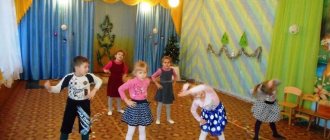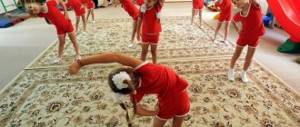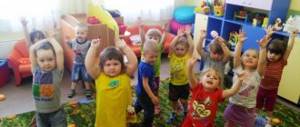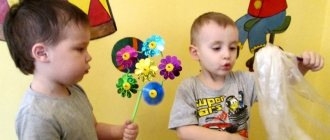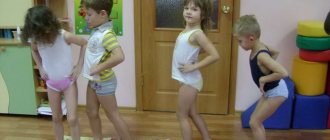At an early age, babies show great activity. They constantly move around the room: jumping, walking and running all day long. Nothing goes unnoticed by the child. If he sees something, he tries to study it. He has a lot of energy. And the task of parents at this stage is to force the child to concentrate on the right thing. We recommend that you encourage your child to lead a healthy lifestyle. To do this, it is necessary to introduce a number of exercises into his life. Let him do exercises in the morning. And during the day he does individual gymnastics exercises. Our editors have put together a special set of exercises for you to exercise. This technique was developed specifically for little toddlers, who are from two to three years old. It differs from standard programs in that it is conducted in a playful way. This allows you to interest the child in training, and instill in him that sports are wonderful. If you exercise regularly with your child, he will learn to exercise from an early age. And he will apply it in his future life, when he becomes an adult. As a result, the baby will get sick less and will always be cheerful.
Introductory part
Morning exercises for a child of this age include from five to six exercises. They are designed exclusively for the baby, and he will be able to complete each of them. Exercises train specific muscle groups: 1. Shoulders and arms. 2. Muscles of the trunk. 3. Legs. 4. Feet. Charging is usually done gradually. First you need to start with preparing for the exercises. Then, after a short warm-up, the child moves on to completing tasks. And after that he gradually stops exercising - this happens at the final stage. Before you start exercising your child, you should think it through as much as possible. Remember, your task is to make sure your baby doesn’t get bored. To do this, morning exercises need to be done playfully. We also recommend that you select only those exercises that will be truly interesting to your baby. The maximum duration of morning exercises should vary from five to seven minutes. To get your child interested in training, we recommend starting your first lessons with exercises that he likes. For example, if your child frequently claps his hands and stomps, include these body movements in your program. The child will happily repeat them. And he won’t notice that, at the same time, he was forced to train. Always encourage your child during activities. If he manages to perform the exercises correctly, and at the same time he does not philander, then praise him. Say that he is great. This way the child will understand that mommy appreciates his diligence and work. Every movement you make should be accompanied by sounds. For example, if you tell your child to clap his hands, then accompany this with the appropriate “clap-clap.” If one of the exercises is stretching, then we recommend saying something like “stretch, stretch” during it. You can reinforce your child’s actions with any sounds. The main thing is that he hears you. And he understood that they were interacting with him. Also ask your child to repeat after you. With this, he will be able to develop respiratory organs.
Examples of exercise therapy for children 2 years old
In order to improve walking, you can use various exercises. If at this age the baby is still unsteady on his feet, then try to encourage him to move along the furniture. When he stands next to the sofa, start luring him with a bright toy, bringing it closer to him and away from him. You can repeat this exercise up to 4 times, depending on your interest.
If you have achieved the necessary progress, you can begin to complete more complex tasks. The first of these will be walking “on a narrow bridge.” To do this, you will need ropes or sticks, with the help of which the path will be built. At first its width will be 30 cm, but gradually it needs to be narrowed. The baby will have to walk along it without stepping on ropes or sticks, maintaining balance.
The next most difficult exercise is walking on an inclined path. To do this you will need a bench or board. One end of it is placed 20-30 cm higher than the other. The child, with the help of an adult teacher, must alternately rise and fall along the surface.
The following group of exercises helps develop a sense of balance
To complete the first task you will need a rocking horse. There is no need to make any special effort on the part of the student. An adult teacher or family member needs to gently rock the horse. This can also be done on regular swings and carousels.
Experienced specialists have one more effective exercise in physical education. It is very simple, but effective. Under the pretext of finding a toy, you invite the baby to climb onto the sofa. Further, the complex can be complicated by asking you to climb higher.
List of exercises for morning exercises
We have selected a number of exercises for you that can be used while charging.
- Fast walk
. At the age of two to three years, babies do not yet know how to fully run. Therefore, the only thing you can ask them to do is walk at high speed. With this exercise your child will be able to:
1. Achieve improved brain activity. 2. Improve the circulatory system. 3. Learning to breathe correctly will make your breathing system stronger. 4. Stretch your muscles.
- March
. During this exercise, the child must march. Of course, he most likely will not have such grace as the military. But he should at least try to march this way. This exercise is performed for thirty to forty seconds. You can even come up with some verse with a clear beat. So that when pronouncing it, the baby stomps correctly. - Catching butterflies
. During this lesson, you need to send your baby to walk around the room. And tell him to catch imaginary butterflies in his hands, clapping loudly. With this exercise he will be able to develop his motor system while having fun at the same time. - Little engine
. This exercise is fun to do if you have several kids. But if you only have one child, you can play together. Your task with your baby is to form a snake. Take each other's shoulders and start moving around the room. The main thing is not to lift your hand from your shoulder.
Specifics of classes with children 2 years old
The exercise therapy program for children aged 1.5 to 2.5 years should consist of active exercises. You can safely put even medium loads into it. But this largely depends on individual characteristics. Some at this age speak well in full sentences, while others know individual words and syllables. The same principle applies to physical development. Some people already confidently run, ride a scooter or ride a cross-country bike, while others are just learning to move well. Experienced experts recommend working with children individually, rather than in groups.
It must be taken into account that children aged 2 years get tired quite quickly, so you need to be extremely careful with the dosage of physical activity. Therefore, the most effective exercises will be those organized in a playful way. If you do not attract the child’s attention and interest, he will begin to shirk from completing planned activities or exercises. Physical education for children 2 years old should be like games, not activities.
Within one lesson, 6-10 planned exercises should be performed. At the same time, it is better to avoid repetitions and create the best possible mood for the children. One of the most effective ways is to quickly explain the essence of the exercise and encourage you to do it, give the exercises interesting names that imitate various actions in life.
Do not forget that the best assistants in this matter are gymnastic equipment such as balls, sticks and benches. It is enough to turn on your imagination and organize for the student a “walk in the forest” or “jumping from shore to shore.” If the weather permits, exercise therapy can be carried out in the fresh air. Summer, spring, autumn or winter - it doesn’t matter, the main thing is that there is no rain or wind.
IMPORTANT! The more children spend in the fresh air, the faster they will develop, remember and have fun. Thus, you can “kill” several birds with one stone. Organize a fun time and perform game exercises.
As we already said, you can use a cross-country bike, scooter or even skis in winter. In this case, it is necessary to constantly secure the child so that he does not fall. The relevance of using this method is high; it will develop reaction, strength and dexterity.
This is what makes physical education for children from 2 to 3 years old different - it allows you to develop the child from different sides. From a medical point of view, the main muscle groups are strengthened and developed, and the condition of the cardiovascular and respiratory systems improves.
Hand exercises
- Exercise "Bird"
. It must be done for at least thirty to forty seconds. The baby’s task is to pretend that he is a bird and wave his arms at the same time.
- Exercise "Fish"
. Tell your child to put their hands together. He needs to start moving them the way a fish does when it swims. The result should be wave-like movements. You need to do this exercise for at least thirty to forty seconds.
- Let's clap our hands
. During this exercise, the child will need to clap his hands. But this must be done from all sides. Several claps need to be done above your head. A few in front of you. And a few behind you. In addition, the child should clap while changing his body position. For example, sitting on the floor, standing on the sofa, lying on the bed, and so on.
Shoulder girdle muscle training
With these exercises, your baby will be able to make his chest stronger. And also develop the respiratory system. Moreover, with the help of this he will learn to hold his back correctly and not slouch.
- Hugs
. Five to six repetitions are allotted for this exercise. The baby needs to do the following. Place your arms to the side. Inhale the air. And then hug yourself by the shoulders. And breathe out. - Steamboat
. Tell your child to put his hands down. And he began to make circular movements with them. So that the arms “rotate” around his shoulders. - Watch
.
Half a minute is allotted to complete this exercise. The child needs to tilt his head alternately. Right-left, and vice versa. In parallel with this, we recommend that you say “tick tock, tick tock” so that the child thinks that he is really acting as a watch. Hands should be placed at your sides. And place your feet at shoulder level. Exercises for the torso Mill
.
Surely in physical education you were forced to do this exercise. The child needs to have his feet shoulder-width apart. Bend over so that your torso is parallel to the floor. And start moving your hands left and right. Just like a mill does. Ten to fifteen seconds are allotted to complete the exercise. Knock Knock
.
First, the child needs to straighten up. And spread your legs parallel to your shoulders. When you give the command, the child needs to make a sharp bend. And start knocking on your knees. You need to spend 20 seconds to complete this exercise. The number of repetitions, in this case, should be from five to six times. Swing
.
During this exercise, you can develop your baby's vestibular apparatus. The child needs to stand on the floor and start swinging in different directions. Stretching
. The child needs to start bending in different directions. Not just left and right. But also back and forth. When the child moves forward, you will only need to extend your hand. We recommend that your child do at least three repetitions.
What exercises are included in play exercises for children.
So, I am ready to present a number of physical exercises for your choice of morning exercises.
So, exercises for all muscle groups of the baby:
1. Running or fast walking . As a rule, a two-year-old baby doesn't quite know how to run, so encourage him to walk quickly. This exercise is very useful for:
- development of the cerebral cortex
- improving the circulatory system
- development of the respiratory system
- warming up almost all muscles of the body.
2. March is a walk, similar to a marching step, which lasts for 30 -40 seconds.
You can learn special poems, for example:
Marching to the parade
I'm very happy with the charger
And I'll tell you what
I'm good with physical education.
3. Catching butterflies . During this exercise, the little one can move around the room in any direction and clap its hands, imitating catching butterflies. If you have a hoop, give it to your child and let him use it as a net to catch imaginary butterflies.
4. Train . If there are several children, then this exercise will be more interesting and exciting. The idea is that everyone present lines up like a snake and, holding each other’s shoulders, imitates a steam locomotive that moves around the perimeter of the room.
Hand exercises.
1. Exercise “Bird” is performed for 30-40 seconds. The baby imitates the flapping of a bird's wings. You can allow your child to run or jump during this time.
2. Fish . We make wave-like movements with our palms folded together, imitating the movement of a fish’s tail while swimming. To perform this exercise, you can allocate 30-40 seconds.
3. Bunny . The essence of this exercise is that the baby claps his hands in all directions: above his head, opposite or behind him, as well as in different body positions: standing, lying, sitting, etc.
Exercises to warm up the shoulder girdle.
By performing such exercises, the baby strengthens the chest and respiratory organs, and also forms correct posture.
1. Hugs . This exercise is performed 5-6 times. The essence of the exercise is that the baby spreads his arms to the sides, inhales, clasps his shoulders and exhales.
2. Steamboat . The baby makes circular swings with straightened arms.
3. Exercise “Clock” is performed for 30 seconds. The toddler tilts his head to one side and then to the other. Tilts are accompanied by comments: “Tick-tock, tick-tock, tick-tock.” He holds his hands on his belt, and his feet shoulder-width apart.
There are also exercises for the torso.
1. Exercise: “Mill” . The baby bends down, puts his feet shoulder-width apart and waves his relaxed arms, imitating the rotating blades of a mill. We perform this exercise for 10-15 seconds.
2. Knock-knock . The toddler, initially, stands straight, and his legs are shoulder-width apart. On command, the child must bend over and pat his knees with his palms. We perform this exercise 5-6 times.
3. Swing . This exercise perfectly trains the vestibular apparatus. The baby, standing in one place, begins to sway, bending its body forward and backward.
4. Pull-ups . The baby leans in different directions: right, left, back and forward with his hand outstretched. It is enough to perform three tilts in each direction.
Exercises that are designed to warm up the legs and feet.
1. Mouse in a hole . The little one hides behind the back of the chair and then straightens up, as if emerging from a hole. You can voice the action with comments: “Ku-ku! Cuckoo! Ku-ku!
2. Ball or grasshopper . The little fidget will happily perform jumps in place or moving to the right or left, back or forward. You can repeat the jumps 15-20 times.
3. Raise your legs higher! The toddler lifts each leg in turn, without bending them at the knees. The exercise is quite difficult, so it is enough for the baby to do 6 lifts.
Exercises for legs and feet
Mouse in a hole
.
For this exercise you will need a chair. Your child should hide behind it. And then start looking out from behind it. Pretending that he is a mouse coming out of his hole. To make it as interesting as possible for your child, we recommend voicing actions. For example, you can say “ku-ku!” Ball or grasshopper
.
During this exercise, the baby should jump and move sharply to the right and left. You need to jump at least fifteen and no more than twenty times. Raise your legs higher
! The baby needs to gradually raise his legs to the top. They must, however, be straight. There is no need to bend them. Doing this exercise is not easy. Especially at this age. Therefore, it will be enough for the child to do 5-6 repetitions.
physical education for children 3-4 years old
Children who master (in general terms) all types of basic movements have a need for motor improvisation to music. The child’s growing imagination stimulates additional motor activity, which is well manifested in outdoor games that form responsibility for following the rules and achieving a certain result. The variety of game plots is associated with children’s ideas and knowledge about the life around them. Pupils develop an interest in improvising various actions when performing a certain role. The teacher needs to encourage the creativity of preschoolers and introduce them to the content of various outdoor games.
Structure of physical education classes
The accessibility of the content of physical education classes is determined by the program material, selected taking into account the age characteristics of children.
Conventionally, the lesson is divided into three main parts: introductory, main and final. Each part has a specific function.
The introductory part (3-5 min) sets up preschoolers to perform motor tasks, activates their attention, and creates a positive attitude. It includes exercises (on toes, raising the knees high, side step, to the sides), running (in a column, with a change of direction, in pairs, in a circle). Children also perform different types of jumps, throwing and catching objects, balance exercises, formations and formations (in a circle, column, in pairs, one after another).
The main part (10-12 minutes) involves solving problems of differentiated teaching of children the main types of movements. For the purpose of rational planning for the entire academic year, it is necessary to distribute the types of movements according to the degree of intensity: high, medium, low.
One of the conditions for the successful implementation of program content for the development of basic types of movements is an individually differentiated approach to children. It is advisable to pre-distribute the pupils into two main subgroups, taking into account their health status, level of motor activity and movement development.
The first group will include children with an average level of motor activity and a fairly good level of movement development. They are offered more basic movements of medium and low activity (80%): game exercises to develop attention, accuracy and dexterity in performing actions, and coordination of movements. High intensity exercise makes up 20%.
The second group will consist of children who have poor health (frequently ill, with disabilities), a low level of development of movements and physical activity. For them, more gaming exercises of medium and high intensity (80%) are offered: exercises aimed at speed of movement, speed, agility, and endurance. Low intensity gaming exercises make up 20%.


